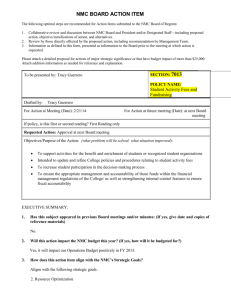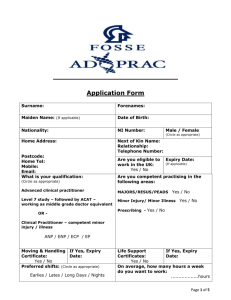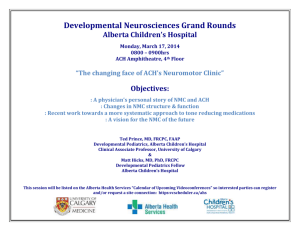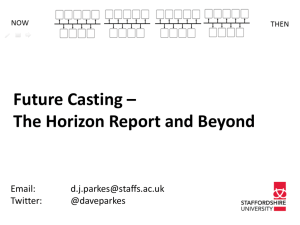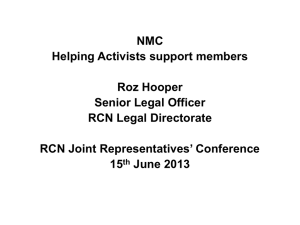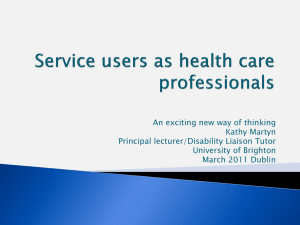NEAR & MIDDLE EASTERN CIVILIZATIONS (NMC) Academic Plan
advertisement
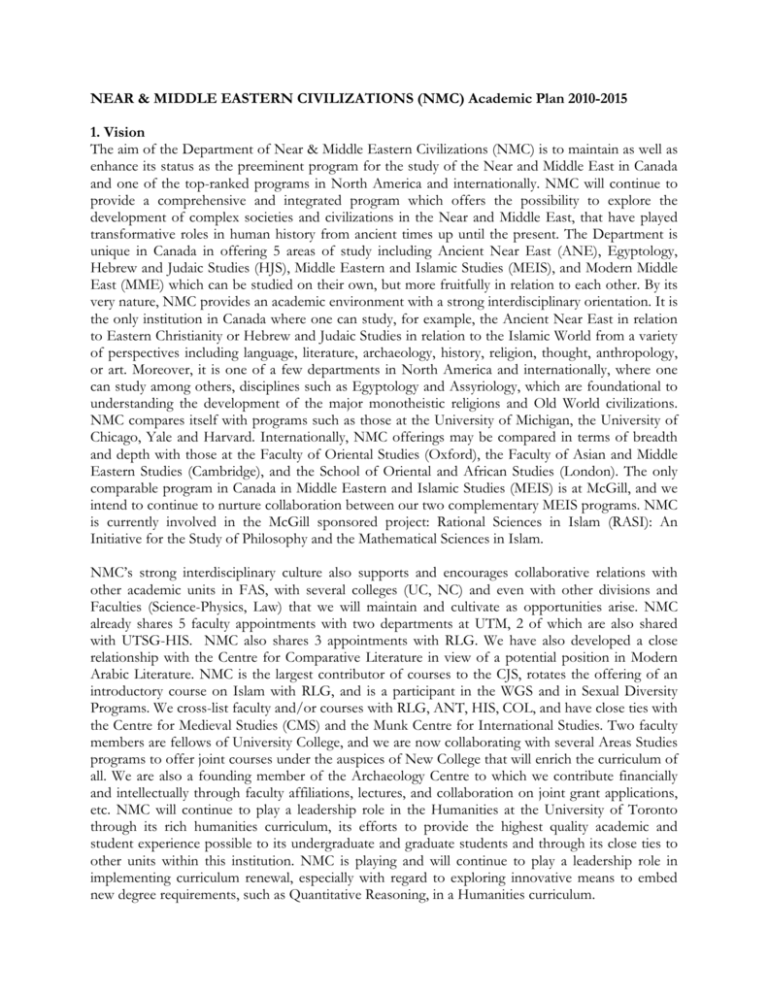
NEAR & MIDDLE EASTERN CIVILIZATIONS (NMC) Academic Plan 2010-2015 1. Vision The aim of the Department of Near & Middle Eastern Civilizations (NMC) is to maintain as well as enhance its status as the preeminent program for the study of the Near and Middle East in Canada and one of the top-ranked programs in North America and internationally. NMC will continue to provide a comprehensive and integrated program which offers the possibility to explore the development of complex societies and civilizations in the Near and Middle East, that have played transformative roles in human history from ancient times up until the present. The Department is unique in Canada in offering 5 areas of study including Ancient Near East (ANE), Egyptology, Hebrew and Judaic Studies (HJS), Middle Eastern and Islamic Studies (MEIS), and Modern Middle East (MME) which can be studied on their own, but more fruitfully in relation to each other. By its very nature, NMC provides an academic environment with a strong interdisciplinary orientation. It is the only institution in Canada where one can study, for example, the Ancient Near East in relation to Eastern Christianity or Hebrew and Judaic Studies in relation to the Islamic World from a variety of perspectives including language, literature, archaeology, history, religion, thought, anthropology, or art. Moreover, it is one of a few departments in North America and internationally, where one can study among others, disciplines such as Egyptology and Assyriology, which are foundational to understanding the development of the major monotheistic religions and Old World civilizations. NMC compares itself with programs such as those at the University of Michigan, the University of Chicago, Yale and Harvard. Internationally, NMC offerings may be compared in terms of breadth and depth with those at the Faculty of Oriental Studies (Oxford), the Faculty of Asian and Middle Eastern Studies (Cambridge), and the School of Oriental and African Studies (London). The only comparable program in Canada in Middle Eastern and Islamic Studies (MEIS) is at McGill, and we intend to continue to nurture collaboration between our two complementary MEIS programs. NMC is currently involved in the McGill sponsored project: Rational Sciences in Islam (RASI): An Initiative for the Study of Philosophy and the Mathematical Sciences in Islam. NMC’s strong interdisciplinary culture also supports and encourages collaborative relations with other academic units in FAS, with several colleges (UC, NC) and even with other divisions and Faculties (Science-Physics, Law) that we will maintain and cultivate as opportunities arise. NMC already shares 5 faculty appointments with two departments at UTM, 2 of which are also shared with UTSG-HIS. NMC also shares 3 appointments with RLG. We have also developed a close relationship with the Centre for Comparative Literature in view of a potential position in Modern Arabic Literature. NMC is the largest contributor of courses to the CJS, rotates the offering of an introductory course on Islam with RLG, and is a participant in the WGS and in Sexual Diversity Programs. We cross-list faculty and/or courses with RLG, ANT, HIS, COL, and have close ties with the Centre for Medieval Studies (CMS) and the Munk Centre for International Studies. Two faculty members are fellows of University College, and we are now collaborating with several Areas Studies programs to offer joint courses under the auspices of New College that will enrich the curriculum of all. We are also a founding member of the Archaeology Centre to which we contribute financially and intellectually through faculty affiliations, lectures, and collaboration on joint grant applications, etc. NMC will continue to play a leadership role in the Humanities at the University of Toronto through its rich humanities curriculum, its efforts to provide the highest quality academic and student experience possible to its undergraduate and graduate students and through its close ties to other units within this institution. NMC is playing and will continue to play a leadership role in implementing curriculum renewal, especially with regard to exploring innovative means to embed new degree requirements, such as Quantitative Reasoning, in a Humanities curriculum. 2 NMC will also maintain and strengthen its relations with the community at the local, national and international levels through its affiliated societies (Society for the Study of Egyptian Antiquities, Canadian Society for Mesopotamian Studies, Canadian Society for Syriac Studies, Canadian Society for Coptic Studies, Toronto Iranian Studies Initiative) that involve the wider community in the intellectual life of the Department, through its close ties with the ROM where NMC has recently cosponsored, financially supported and co-coordinated the Dead Sea Scrolls Symposium and with the AGO with whom it is currently partnering to provide programming for the King Tut exhibition. Worthy of note is that these two exhibits have already drawn record attendance and that attendance is expected to exceed all previous records. NMC will thus continue to enhance the visibility of the University, Faculty and Department through these and other community activities. NMC will also continue to provide international leadership in ethical treatment of cultural properties and collections of excavated artifacts. NMC “digs” are cited as role models in this regard. The Department will also continue its efforts to reflect the demographics of our community in the GTA and provide newcomers of all national, ethnic and religious affiliations from the Middle East and Islamic World more broadly with a point of access in the University. NMC, with support from the Dean’s Office and Massey College, has hosted two Scholars at Risk over the last few years, one from Iran and most recently one from Gaza. The Scholar Rescue Fund at the Institute of International Education in New York has presented the Chair of NMC with an Award for Outstanding Service for her efforts and those of the Department to provide refuge for the Scholar at Risk from Gaza. 2. Key Strengths The merger of the former Department of Near Eastern Studies with the former Department of Middle East and Islamic Studies on July 1, 1996 created a vibrant, interdisciplinary unit, unique in Canada. The two former departments under various designations have existed in the University of Toronto for over 150 years. The merger succeeded in fostering the consolidation and integration of resources for the study of Near and Middle Eastern cultures and civilizations to a degree that is unavailable elsewhere in Canada. Courses in languages, philology and linguistics, literatures, archaeology, history, thought, anthropology, and art give access to a cultural region that is at the geographical origin of three of the world’s major religions—Christianity, Judaism and Islam—that is a wellspring of Western civilization, and that is strategically important in the modern world. The integration of these formally separate units through rationalization of the curriculum and some new appointments has created a program in which it is now possible to acquire a deep, interdisciplinary knowledge of the Near and Middle East, including the Islamic World, from a variety of perspectives, from ancient to modern times, rather than the more superficial knowledge commonly provided by the media. a.i) Research and scholarship: NMC’s research and scholarship are grounded in the use of primary sources, whether archaeological or textual, that is the essential basis for further academic study and research in the field regardless of discipline. Language-based research is thus a key strength of the Department. In his 2009 Massey Lectures published as The Wayfinders: Why Ancient Wisdom Matters in the Modern World,* the Canadian anthropologist Wade Davis stated, “A language…is not merely a set of grammatical rules or a vocabulary. It is a flash of the human spirit, the vehicle by which the soul of each particular culture comes into the material world. Every language is an old-growth forest of the mind, a watershed of thought, an ecosystem of spiritual possibilities.” NMC’s strength is both to contribute to the preservation of the ancient and medieval languages and cultures of the Near and Middle East and the human knowledge contained therein and to make them, and their modern heirs, accessible. Archaeological artifacts and remains constitute another primary source for the study of the region. NMC offers Egyptology 3 (archaeology), Mesopotamian archaeology, Syro-Palestinian archaeology, and until recently, Islamic archaeology, in relation to the study of the ancient and Islamic periods. Archaeology in NMC is exceptionally strong. Each of NMC’s areas of strength is supported by its internationally recognized high-profile faculty, who are fully engaged in research and teaching at both the undergraduate and graduate levels. At present, NMC tenured and tenure stream faculty number 14 who are distributed across all 5 areas of strength: ANE (4.00 FTEs); Egyptology (2.00 FTEs); HJS (2.82 FTEs); MEIS (3.33 FTEs); MME (1.85 FTE). In addition, 1.70 FTE teaching stream appointments are responsible for instruction in 2 high demand languages: Arabic and Persian. NMC also draws on a 1.00 FTE continuing appointment, a 1.00 FTE CLTAship in Egyptology and a 0.5 FTE CLTA appointment in HJS. One tenure stream faculty member, whose appointment in at UTM-Historical Studies does graduate teaching in NMC. His field is essential to the study of Ancient and Late Antique Iran before Islam. Finally, NMC is also able to draw on resources at the ROM. Currently, 3 crossappointments, one in Egyptology (with a focus on Nubia, archaeology), one with expertise in archaeological materials, archeometry, and in the medieval period, and a third with specialization in Islamic art and architecture, enrich NMC’s research and teaching capabilities. Forty-two percent of NMC tenured and tenure stream faculty currently hold SSHRCs, a percentage exceeded only by Philosophy and Linguistics among Humanities departments. The success rate in SSHRC research grant applications is 33% according to FAS indicators, and the total funding relative to tenure-stream faculty FTEs is $17,244, a little above the average among Humanities Departments. NMC compares most closely with the Department of English. In addition, one tenured faculty member with a shared appointment holds a SSHRC grant as do one continuing 100% FTE appointee and one CLTA appointee, though their grants are not reflected in the FAS indicators. NMC faculty are productive researchers, engaged in cutting edge research. Between 2004 and 2009, our 14 tenured and tenure stream faculty published at least 17 books, 57 articles, 37 chapters, 31 encyclopedia or other articles in reference works, and 29 reviews in refereed publications. NMC faculty are also award-winning scholars. M. Subtelny’s Timurids in Transition: Turko-Persian Politics and Acculturation in Medieval Iran, was awarded the Houshang Pourshariati prize at the Middle East Studies Association annual conference in 2008 for best monograph. In 2004 she was the recipient of the Saidi-Sirjani Book Award for Le monde est un jardin: Aspects de l’histoire culturelle d’Iran médiéval (Paris, 2002), awarded by the International Society of Iranian Studies for the best book in Iranian studies.T. Harrison received the Fellner Award for Best Scholarly Book on Archaeology in 2004 for his publication of Megiddo 3. C. Reichel was awarded the TOPOI Excellence Cluster Fellowship (2009): The TOPOI Excellence Cluster (http://www.topi.org), a program funded by the German government, that pursues the goal of researching the interdependence of space and knowledge in the civilizations of the Ancient Near East, the Mediterranean, and Black Sea region and parts of the Eurasian steppe from the 6th millennium BC to around AD 500. The American Institute of Archaeology (AIA) also selected Reichel as the prestigious Kershaw Lecturer for 2009-10. Recently, W. Saleh has received preliminary notification of his selection as a Mellon New Directions Fellowship recipient, an award that will be confirmed in March 2009. The international standing of NMC faculty is highlighted by the fact that 3 NMC faculty, one of whom is a graduate of NMC and now cross-appointed from McMaster to its Graduate Faculty, head the 3 main scholarly associations in the field of Near & Middle Eastern civilizations. T. Harrison currently serves as President of the American Schools of Oriental Research; V. Aksan is President of the Middle East Studies Association of North America; and M. Tavakoli, is President of the International Society for Iranian Studies (ISIS). In addition, he is Editor-in-Chief of Comparative Studies of South Asia, Africa and the Middle East (Duke UP), Co-editor of the Iranian Studies Book 4 Series, published by Routledge, and on the editorial boards of Iranian Studies, the journal of the ISIS, of Iran Nameh, and of Rahvard, both Persian journals of Iranian studies. The loss of the Classical Arabic position and failure to search for the Modern Arabic position have considerably weakened the MEIS and MME areas in NMC, i.e., the modern period from the rise of Islam to present day. The lack of Arabic literature in the curriculum threatens the coherence of NMC’s program, not to mention the higher levels of language learning, and needs to be addressed. Potential retirements over the next five years may also have a debilitating effect on NMC’s ability to offer its programs. Only Modern Middle East at present will not be affected. The Department stands to lose substantial ground. a.ii) Graduate education. NMC led the Faculty with respect to graduate expansion and was cited by FAS as a role model for graduate recruitment. Between 2004 and 2009 total enrolment in the graduate program grew from 71 to 82. MA enrolment expanded during that period from 19 to 27. PhD enrolment grew more slowly from 52 to 55, partly because of the constraints we face in admitting visa students, the traditional pool from which NMC has drawn its graduate population. NMC has the highest total FTE enrolment relative to tri-campus supervisory capacity (5.28) of any Humanities department at the UofT. Applications to the program have tripled between 2004 and 2009. The competition for admission is fierce, but the resulting competitive atmosphere has produced a graduate cohort that is successful in granting competitions, in honours and in placements upon graduation. In 2009-10 3 NMC graduate students were the recipients of CGSDs and 3 received CGSMs. In 2009-10 3 PhD students received OGS fellowships and 3 PhD students and 1 MA student received OGS fellowships for a total of 4. 3 of these 4 students also received a SSHRC. 4 NMC graduate students held a Connaught in 2008-09. In the two years of its existence, a total of 5 NMC students were awarded Avie Bennett fellowships. 1 student won a Chancellor Jackman Fellowship in 2005-06. .88 PhD degrees and 3.88 MA degrees were awarded relative to tricampus supervisory capacity. Average time to completion is 6.78 years, probably reflecting the time it takes to acquire the necessary language skills. 71% of students who responded to the CGPSS survey regarding quality of academic experience rated NMC as either Excellent or Very Good. In order to make its areas of strength more visible, NMC is moving to create OCGS fields that correspond to its previously mentioned core areas. The foundation of graduate education in NMC in each of these fields, however, is the acquisition of the tools, especially a high level of language skill, that enable students to engage with the primary sources. Admission to the graduate program in NMC requires some previous, relevant language training, and by the time students write their doctoral exams in PhD 3, they must demonstrate that they have attained a high level of ability to use the primary source languages associated with their research. The NMC graduate student body is engaged in cutting edge, award-winning research. Awad Eddie Halabi (Supervisor: J.A. Reilly), for example, won the Malcom H. Kerr Dissertation Award in 2008 that was presented at the Middle East Studies Association of North American Annual Meeting that year. Professional training and development opportunities abound for NMC graduate students. The Department offers several TA instructorships and provides additional training and mentorship for them. NMC graduate students also have professional development opportunities associated with cultural institutions in the GTA. NMC graduate students have been heavily involved in two major exhibitions, the recent Dead Sea Scrolls Symposium and on-going Exhibition at the ROM and the King Tut exhibition at the AGO. NMC graduate students presented papers in the Dead Sea Scrolls Symposium co-sponsored by NMC and co-organized by Prof. S. Metso (NMC). Faculty directing excavations in Jordan, Syria, Turkey, and Nubia involve graduate students in their field work, some of whom eventually become field directors and site supervisors on NMC directed and other sites (e.g., C.J. Gohm is Senior Field Director, Wadi ath-Thamad Project, Jordan, J. Ferguson is a ROM 5 instructor and a Director of the Regional Survey, Wadi ath-Thamad). Graduate students may also be involved as research assistants in faculty directed research projects. NMC graduates are successful in finding employment. Recent NMC graduates have been appointed to positions in Canada at University of Western Ontario, York, Dalhousie, Carleton, Trent, Memorial, the University of Manitoba, the University of Lethbridge and Okanagan College; in the USA at the University of Memphis, University of Alabama, Roger Williams University (RI, USA), Wright State University (Ohio), Jewish Theological Seminary (NYC), Grand Valley State University (MI, USA), and San Joaquin Delta College, (CA, USA); and internationally at the University of Liverpool (UK), Leo Baeck Institution and Kings College (London, UK), University of Auckland, and the American University of Sharjah, among others. NMC graduate students have an active graduate students association. For the last 14 years they have sponsored a Graduate Student Symposium that is now drawing participation from North America, Europe and the Middle East. The proceedings are published as funding permits. In addition they sponsor workshops on a variety of issues, such as, for example, the job hunt and job applications, etc., as well as social events. They have also launched a mentoring program for new graduate students and a “buddy” system in an effort to insure that all graduate students feel included in our multi-ethnic, multi religious environment. a.iii) Undergraduate education: The NMC Specialist Program, which prepares students for graduate study among other things, requires study of two NMC languages to the intermediate level. Students in a Major Program may include language study depending on their interests and needs. Students may study Akkadian (Old Babylonian), Aramaic, Syriac, Hebrew (Biblical, Middle, Modern), Arabic, Persian and Turkish in relation to literature, philology and linguistics, history, religion and thought, anthropology and art. Along with textual materials, archaeological artifacts and remains constitute another primary source for the study of the region. NMC offers undergraduate courses in Egyptology (archaeology), Mesopotamian archaeology, Syro-Palestinian and until recently, Islamic archaeology. Currently, excavations in Jordan, Syria, Turkey, Egypt, and Nubia, directed by NMC faculty, provide experiential learning possibilities for NMC undergraduate as well as graduate students. Undergraduates may enroll in a fieldwork course (NMC 261Y), operated by Woodsworth Summer Study Abroad Program that includes academic work and participation in a faculty directed dig in Jordan. Tenured, tenure stream and our high-quality continuing faculty, including CLTAs and ROM cross-appointees, teach the majority of undergraduate courses. Very few courses are taught by sessionals as the FAS indicator (.52) might suggest. The average score on Question 11 of the course evaluations for all courses is 5.97, one of the highest ranked departments according to FAS indicators. The high quality teaching evidenced by student opinion is further confirmed by the fact that NMC tenured and continuing faculty win internal and external teaching awards: Harrak: 2006 (Spring), Macleans Magazine Popular Teacher Recognition; Lawson 2006 (Spring), Macleans Magazine Popular Teacher Recognition; Leprohon: 2006 (April), Semi-finalist “Ontario’s Best Lecturer” competition, for TVO’s “Big Ideas” program and in 2004, Faculty of Arts & Science Outstanding Teaching Award. A key strength of NMC is the small class experience. 82% of NMC courses are classified as “providing small-group learning opportunities relative to total teaching activity.” Language classes are invariably small by FAS standards. No measures are available for the number of large NMC lecture courses that include a small-group learning opportunity, although some NMC courses do now incorporate this kind of experience. Tutorials are now scheduled for some of the larger classes with enrolments of 80 and more. (e.g., NMC 101Y, NMC 184H, NMC 185H, NMC 273Y). NMC undergraduates have an active student union that has won ASSU awards for its activities, which range from sponsoring academic lectures and mentoring for students to social events. 6 b) Enhancement of these strengths over the last 5 years b.1) Research and scholarship: NMC has acted to improve the quality of language instruction that is the foundation for study in all fields in NMC. NMC and NMC-UTM applied to AIF competitions and received two positions, one 1.00 FTE in Arabic Language instruction and one .70 position, shared with UTM-Dept. of Language Studies, in Persian and it hired first rate scholars and teachers. Both are products of linguistics programs and are dedicated teachers who garner top evaluation scores and are engaged in publishing pedagogical materials and research. They are also active participants in FAS sponsored language related events. Arabic language instruction has been completely restructured and updated, as has Persian language instruction. 4 levels of Arabic are now offered. An extra section of the Introductory Arabic course, taught by a TA instructor, trained and mentored by the Lecturer, has been added in response to high demand. The teaching of Modern Hebrew has been systematized with the mapping out of an updated curriculum and the decision to replace sessional instructors with TA instructors who receive additional training and mentorship from an HJS faculty member. A similar effort is being made with Turkish, but without the same level of FAS support received for Modern Hebrew. ANE and Egyptology have been strengthened. NMC has made two bids for a Jackman Chair since 2004. The ANE and Egyptology areas of NMC research and scholarship have thus been greatly strengthened. The Department has supported archaeology with the renovation of the Archaeology Lab on the 4th floor of Bancroft Hall, with the appointment of a Lab Technician and Collections Administrator, and with financial support and participation in the activities of the Archaeology Centre. NMC contributes to the funding of the Lab Tech position. The position has greatly strengthened NMC research capabilities in NMC, graduate education in archaeology, the management of its collections and the work necessary to maintain NMCs several faculty directed excavations. In 2006 the Chair initiated a Chair’s Distinguished Lecture Series, entitled “Scholars without Borders,” in further support of continued integration of the 5 areas of strength in the Department. b.ii) Graduate education: NMC is anxious to internationalize its graduate student cohort to a greater extent than is now possible and has, therefore, with approval of the Dean’s office, put some of its own resources on the table in order to increase our quota. Traditionally our applications come not from Canada, but from the USA and abroad. In recent years the funding situation has forced us to turn down many outstanding applicants for this reason. While putting resources into recruitment of visa students, the Department has also begun to cultivate bright and interested domestic MA students, most of whom have entered from our undergraduate program, the only one in Canada that prepares students for graduate study in NMC. NMC is in the process of creating new OCGS fields that correspond to our 5 areas of strength. NMC is also working to improve the structure of its major and minor fields programs in accordance with the areas of strength that have been identified. NMC is developing new ways to provide graduate students with high-level research opportunities. For example, in collaboration with the Center for European Islamic Thought and the New Islamic Public Sphere Program at the University of Copenhagen and the Danish Institute in Damascus, NMC has launched a Master Class program on “Islam and Muslims in a Plural World: The Local and the Global in the Middle East, Europe and North America” for Graduate Students working in the area of Modern Middle East. Up to 4 NMC graduate students will have an opportunity to meet in Damascus with graduate students from the Center and Program at the University of Copenhagen to present and discuss their dissertation research and that of the associated faculty members. One NMC faculty member will participate in the Master Class faculty each year. The Master Class will be held annually during the break between the spring and summer terms. 7 NMC has negotiated professional development and training opportunities for graduate students with two major cultural institutions in the GTA, the ROM and the AGO, as already described. Prof J. Hanssen, in collaboration with his graduate student, was awarded a Jackman Working Group Grant for “Crossing Boundaries: Resituating North African and Middle Eastern Studies. b.iii) Undergraduate education: NMC has improved language instruction. Two excellent teaching stream faculty, charged with instruction in Arabic and Persian have been hired. Steps have also been taken to improve the quality of instruction in Modern Hebrew and Turkish. NMC has mapped out an updated curriculum in Modern Hebrew and replaced sessional with TA instructors in Modern Hebrew as well as in Turkish who receive extra TATP training and mentoring. NMC is introducing new “gateway courses” that, despite expected large enrolments, will also increase the number of small group experiences available and enhance student experience by means of tutorials. The entry level courses required for Specialist and Major Programs, NMC 101Y Intro to the Ancient Near East and NMC 184H The Islamic World and NMC 185H Introduction to Islam, with over 150 students enrolled in each, NMC 273Y Islamic History to the Fall of Baghdad, and NMC 278H Intro to the Modern Middle East, already run tutorials that provide the small group experience. Others are being developed using this model. NMC’s success in two competitions, WIT and CRIF, which secured additional resources to improve undergraduate teaching, has led to a de facto complete renewal of our undergraduate curriculum. Although writing has always been a concern in NMC, WIT has provided an opportunity for NMC to look at its curriculum anew, to improve sequencing of courses according to learning expectations and outcomes at each level, and to develop innovative assignments and activities to improve writing among undergraduates. WIT has resulted in other unforeseen benefits, e.g., the development of a course team approach and a real esprit de corps among graduate students and faculty involved in WIT. NMC’s successful proposal to CRIF in 2008-09 for the development of a module bank as a way to embed Quantitative Reasoning into its Humanities curriculum has led to involvement with HEQCO, resulting in some additional funding as well as access to expert consultants. NMC is increasingly viewed as a Faculty leader in its bold efforts to experiment with implementing Curriculum Renewal and the new degree requirements. 3. Priorities a) Languages in NMC are foundational and must be strengthened. To maintain its status as a topranked program nationally and internationally NMC will need a tenure-stream Professorial position in Classical Arabic immediately. Classical Arabic is the principal, integrating language for the study of Semitic philology. In fact, knowledge of Arabic is essential even for the study of Ottoman Turkish, an Altaic language, and for Persian, an Indo-European language, both of which were written in Arabic script and heavily influenced by Arabic vocabulary and terminology. The Classical Arabic position relates to nearly every other area of study in NMC, whether history, thought, religion, or even art. A tenure stream position in Modern Arabic, to be shared with COL, is a second priority. A Lecturer to firmly ground Modern Hebrew language instruction is another desideratum. b) Potential retirements over the next 5 years, equivalent to 5.33 FTEs, will affect the Ancient Near East, Egyptology, Hebrew and Judaic Studies, and Middle East and Islamic Studies. It will be imperative to address these losses as they occur since they will undermine our preeminent status. In addition, however, NMC also needs positions in Modern Middle East history, Modern Persian Literature, Turkish studies, and Ancient Near Eastern history. c) NMC has prioritized the creation of new gateway courses in its core areas of study in connection with its efforts to improve curriculum with better sequencing. The new gateway courses as well as those that already exist are expected to attract large enrolments. An increase in TA hours will make it possible to add tutorials to enhance student learning and provide more, small group learning 8 experiences even in these larger courses, while providing graduate students with teaching invaluable experience. d) The WIT and CRIF QR initiatives have had positive benefits for instructors and TAs, as well as undergraduate students. To ensure the sustainability of this program, a position, perhaps shared, should be created for a Coordinator who will continue to manage WIT, just as our excellent LWTA has done for the last 2 ½ years. More TA hours are needed for NMC WIT and CRIF QR projects. e) Space is a priority. The Department needs additional space for a conference room large enough to host departmental lectures and equipped with up-to-date smart technology, TA space and a lounge where faculty and graduate students can meet. f) Making NMC’s considerable strengths more visible is a priority. In addition, while NMC is the base for study of Islam at UofT, several other departments and campuses are now offering related courses. It will be important to make tri-campus offerings for the study of the Islamic World more visible at UofT through the creation of a web site. 4) Achieving Priorities a) It is imperative that the Department begin the search for a tenure-stream Professorship in Classical Arabic as soon as possible. NMC will be unable to fill this position without FAS support. b) NMC will address the potential losses to retirement over the next few years as retirements occur and the financial situation evolves. In addition to potential losses to retirement, NMC has other needs, as listed above. NMC will have to wait for a new infusion of money from FAS or external sources. HUM 199s should be eliminated so that diminished resources can be devoted to NMC core needs. c) Restructuring of NMC undergraduate curriculum would be greatly facilitated by more TA hours both independently and in conjunction with WIT hours and training. These TA hours would be used for tutorials in large classes and to support writing and the introduction of new competencies into the curriculum. HUM 199 funding should be redirected to fund increased TA hours in Departments like NMC where small group experiences already exist in abundance. d) WIT can be sustained only with the hire of a permanent LWTA or person who has a coordinating function in the Department. Perhaps the position could be shared with other WIT departments. e) NMC proposes to expand its space to include the first floor of Bancroft Hall. f) NMC is proposing new OCGS fields to enhance visibility of our strengths. NMC also plans to renovate its website. NMC also proposes to take the lead in creating a link for UofT that will make Islamic Studies offerings across the three campuses visible. If NMC were to be granted another $100K, we would use a portion of it, together with the remainder of a salary that is still in NMC’s base budget, in order to fund the shared NMC/COL position in Modern Arabic. * Wade Davis, published as The Wayfinders: Why Ancient Wisdom Matters in the Modern World (Toronto: Anansi, 2009), 3.
